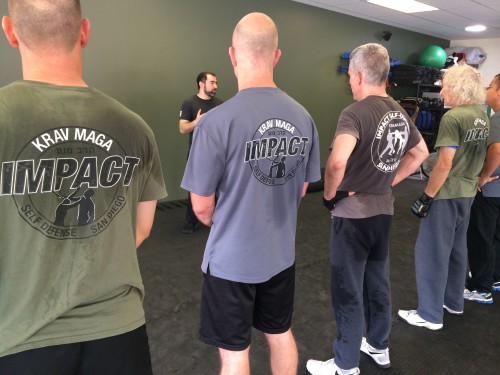

Submissions, Restraining Techniques and Krav Maga
We often get asked the question of why we do not teach many restraining techniques and submissions in our regular Krav Maga classes. The answer to this question is that we do in fact teach some restraining methods and submissions. But this is done much later in the student’s development as a fighter and is done in a matter that is consistent with the reality of a fight on a street. Let us expand a little bit more about this subject.
The basis for this question comes from exposure to competitive MMA matches and a misunderstanding of how that relates to the reality of a violent street altercations. The truth is that most restraining techniques work only if there are number of people trying to restrain a smaller set of combatants. In fact, you often see a single police officer struggling to restrain a single aggressive attacker using only restraining (soft) techniques. To succeed they often rely on help from other officers, and/or the use of non-lethal weapons such as pepper spray and tasers. Since we, as civilians, cannot call for backup in the midst of a violent struggle, reliance on soft solutions and restraining methods alone is not sufficient for us to deal with a dangerous aggressor. Hard actions call for hard solutions, hence most Krav Maga techniques rely on strong and aggressive counterstrikes designed to quickly and efficiently neutralize an attacker and escape.
Of course submissions do have some purpose in combat situations, but they usually take too long to master and too long to execute and are prone to failure. MMA fights can last up to 25 minutes, where competitors wear each other out with strikes and grappling in hopes of creating an opening for a knockout or a successful submission. Plus these matches happen on soft surfaces, with rules, without the use of weapons and without the possibility of multiple attackers. Street altercations are very different, and far more dangerous. Hence the “rules of engagement” are very distinct and call for fast responses that are suitable to all fighting surfaces, to people of all sizes and strengths, taking into account the possibility of encountering a weapon and multiple assailants. So, when facing a life or death struggle, we want the quickest, most efficient and easiest techniques to execute in order to escape unharmed. If you find yourself in a ground struggle, it is much easier to keep striking the person while trying to get up rather than looking to set up a triangle choke submission, giving more opportunities for your opponent to fight back, thus increasing the chance of sustaining more damage from the immediate attacker, other potential attackers and the surface itself (pavement, etc.)
But, like we mentioned earlier, we do encounter some restraining methods and submissions later in the syllabus, but only if they are in line with the underlying principle of Krav Maga, which is to do what is necessary to end the conflict quickly and efficiently without sustaining unnecessary damage.
Think of the process of learning Krav Maga like the process of building a pyramid. The base of the pyramid is the key; it holds the whole structure together. The base of Krav Maga is our key to successfully dealing with self-defense and combat situations. It incorporates a set of effective, relatively simple, instinctive movements that are interconnected and are based on standard underlying principles that are recycled from technique to technique. (To read a bit more about how we teach Krav Maga as a system, please read April issue). Once that foundation is set, we build upon it new set of slightly more complex skills that relate to the previous material. Once the next layer is solidified, more material is laid upon it. Ultimately we do teach some restraining tactics and submissions, but with the idea that if they fail, you have the knowledge to fall back on the lower levels of the pyramid to deal with the problem at hand. If we were to teach these techniques early on in the development of a fighter, any failure to perform these techniques efficiently in a realistic struggle would cause the person to fail completely, given that they would have no previous skills to fall back on. Similarly to how a pyramid would crumble if the foundation and the base would not be laid correctly before layering more material on top.
Bottom line is that the longer you train Krav Maga the more tools you have at your disposal to deal with an attack. However, a student training for only a few months should still be able to defend himself with a simple set of combative tools without having to rely only on complex movements that are prone to failure and those that require advanced skills to execute correctly. If Krav Maga was all about complex submissions and restraining techniques, then it would be far from the simple and effective system that it has proven to be over the decades of its existence in the military and civilian sectors.

A very illustrative article, thanks IMPACT people !!
Thank you, Sal!